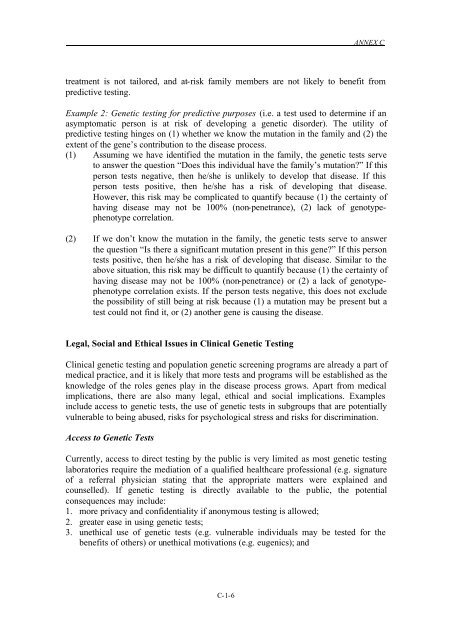Medical, ethical, legal and social issues in genetic - Bioethics ...
Medical, ethical, legal and social issues in genetic - Bioethics ...
Medical, ethical, legal and social issues in genetic - Bioethics ...
You also want an ePaper? Increase the reach of your titles
YUMPU automatically turns print PDFs into web optimized ePapers that Google loves.
C-1-6<br />
ANNEX C<br />
treatment is not tailored, <strong>and</strong> at-risk family members are not likely to benefit from<br />
predictive test<strong>in</strong>g.<br />
Example 2: Genetic test<strong>in</strong>g for predictive purposes (i.e. a test used to determ<strong>in</strong>e if an<br />
asymptomatic person is at risk of develop<strong>in</strong>g a <strong>genetic</strong> disorder). The utility of<br />
predictive test<strong>in</strong>g h<strong>in</strong>ges on (1) whether we know the mutation <strong>in</strong> the family <strong>and</strong> (2) the<br />
extent of the gene’s contribution to the disease process.<br />
(1) Assum<strong>in</strong>g we have identified the mutation <strong>in</strong> the family, the <strong>genetic</strong> tests serve<br />
to answer the question “Does this <strong>in</strong>dividual have the family’s mutation?” If this<br />
person tests negative, then he/she is unlikely to develop that disease. If this<br />
person tests positive, then he/she has a risk of develop<strong>in</strong>g that disease.<br />
However, this risk may be complicated to quantify because (1) the certa<strong>in</strong>ty of<br />
hav<strong>in</strong>g disease may not be 100% (non-penetrance), (2) lack of genotypephenotype<br />
correlation.<br />
(2) If we don’t know the mutation <strong>in</strong> the family, the <strong>genetic</strong> tests serve to answer<br />
the question “Is there a significant mutation present <strong>in</strong> this gene?” If this person<br />
tests positive, then he/she has a risk of develop<strong>in</strong>g that disease. Similar to the<br />
above situation, this risk may be difficult to quantify because (1) the certa<strong>in</strong>ty of<br />
hav<strong>in</strong>g disease may not be 100% (non-penetrance) or (2) a lack of genotypephenotype<br />
correlation exists. If the person tests negative, this does not exclude<br />
the possibility of still be<strong>in</strong>g at risk because (1) a mutation may be present but a<br />
test could not f<strong>in</strong>d it, or (2) another gene is caus<strong>in</strong>g the disease.<br />
Legal, Social <strong>and</strong> Ethical Issues <strong>in</strong> Cl<strong>in</strong>ical Genetic Test<strong>in</strong>g<br />
Cl<strong>in</strong>ical <strong>genetic</strong> test<strong>in</strong>g <strong>and</strong> population <strong>genetic</strong> screen<strong>in</strong>g programs are already a part of<br />
medical practice, <strong>and</strong> it is likely that more tests <strong>and</strong> programs will be established as the<br />
knowledge of the roles genes play <strong>in</strong> the disease process grows. Apart from medical<br />
implications, there are also many <strong>legal</strong>, <strong>ethical</strong> <strong>and</strong> <strong>social</strong> implications. Examples<br />
<strong>in</strong>clude access to <strong>genetic</strong> tests, the use of <strong>genetic</strong> tests <strong>in</strong> subgroups that are potentially<br />
vulnerable to be<strong>in</strong>g abused, risks for psychological stress <strong>and</strong> risks for discrim<strong>in</strong>ation.<br />
Access to Genetic Tests<br />
Currently, access to direct test<strong>in</strong>g by the public is very limited as most <strong>genetic</strong> test<strong>in</strong>g<br />
laboratories require the mediation of a qualified healthcare professional (e.g. signature<br />
of a referral physician stat<strong>in</strong>g that the appropriate matters were expla<strong>in</strong>ed <strong>and</strong><br />
counselled). If <strong>genetic</strong> test<strong>in</strong>g is directly available to the public, the potential<br />
consequences may <strong>in</strong>clude:<br />
1. more privacy <strong>and</strong> confidentiality if anonymous test<strong>in</strong>g is allowed;<br />
2. greater ease <strong>in</strong> us<strong>in</strong>g <strong>genetic</strong> tests;<br />
3. un<strong>ethical</strong> use of <strong>genetic</strong> tests (e.g. vulnerable <strong>in</strong>dividuals may be tested for the<br />
benefits of others) or un<strong>ethical</strong> motivations (e.g. eugenics); <strong>and</strong>


